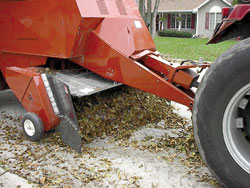
If you're looking for a new source of part-time income, take a look at this attachment for big square balers that's designed to pick up leaves on city streets.
"There's a big market for leaf removal and with this equipment you don't have to make a huge investment to get started," says Tim Perry, Tap Industrial Products, Waupun, Wis.
The company's "Street Saver" uses abrasion-resistant nylon brushes that cleanly sweep material into the head. The brushes mount behind the tines on the existing baler pickup. The brushes, which are staggered, sweep up leaves and yard debris from smooth, paved surfaces. The kit includes two side panels made from 3/4-in. thick UV-resistant poly that funnel leaves into the baler; a 12-in. wide, 3-ply "gravel belt" that mounts along the bottom of the baler and protects against accidental contact with a street curb or other object; the brushes; an under-frame pavement scraper on back that pushes material forward so that the brushes can continually sweep the material up into the head; and a 1/2-in. thick, UV-resistant poly cover that mounts over the baler pickup and helps funnel the leaves into the bale chamber.
The kit fits three major brands -- the Case-IH 8575, AGCO Hesston 4755, and New Idea 7233. It bolts on using existing holes, with no modifications required to the baler.
"It reduces leaf collection time from days to hours and can save towns a great deal of time and money," says Perry, who put the kit on the market this fall. "Most towns and cities currently use some combination of grinder-blowers, payloaders, and snowplow trucks. The grinder-blowers require a lot of maintenance and in many cases are old and quite worn. By hiring someone with a baler equipped with our kit, all the city has to do is get the leaves onto the street. Another advantage of our system is that it greatly reduces dust compared to grinder-blowers. It can even handle heavy, wet leaves."
According to Perry, a standard baler won't work with leaves because the tines miss 25 to 30 percent of them. "We chose these three baler models because they're equipped with pre-charge chambers that pound material into the bale chamber, putting a maximum amount of material in each bale," he notes.
